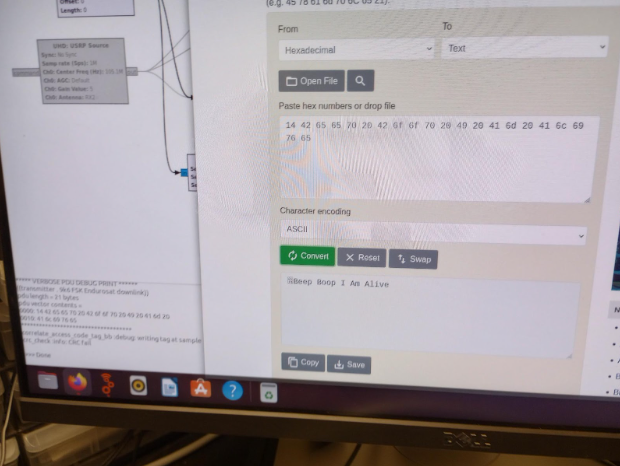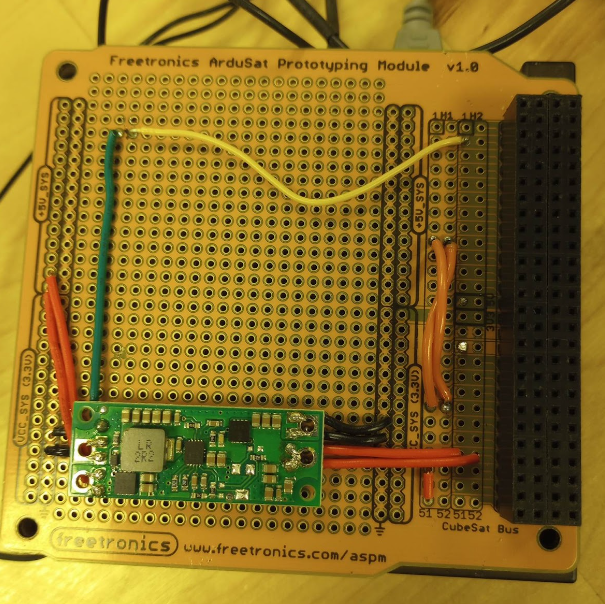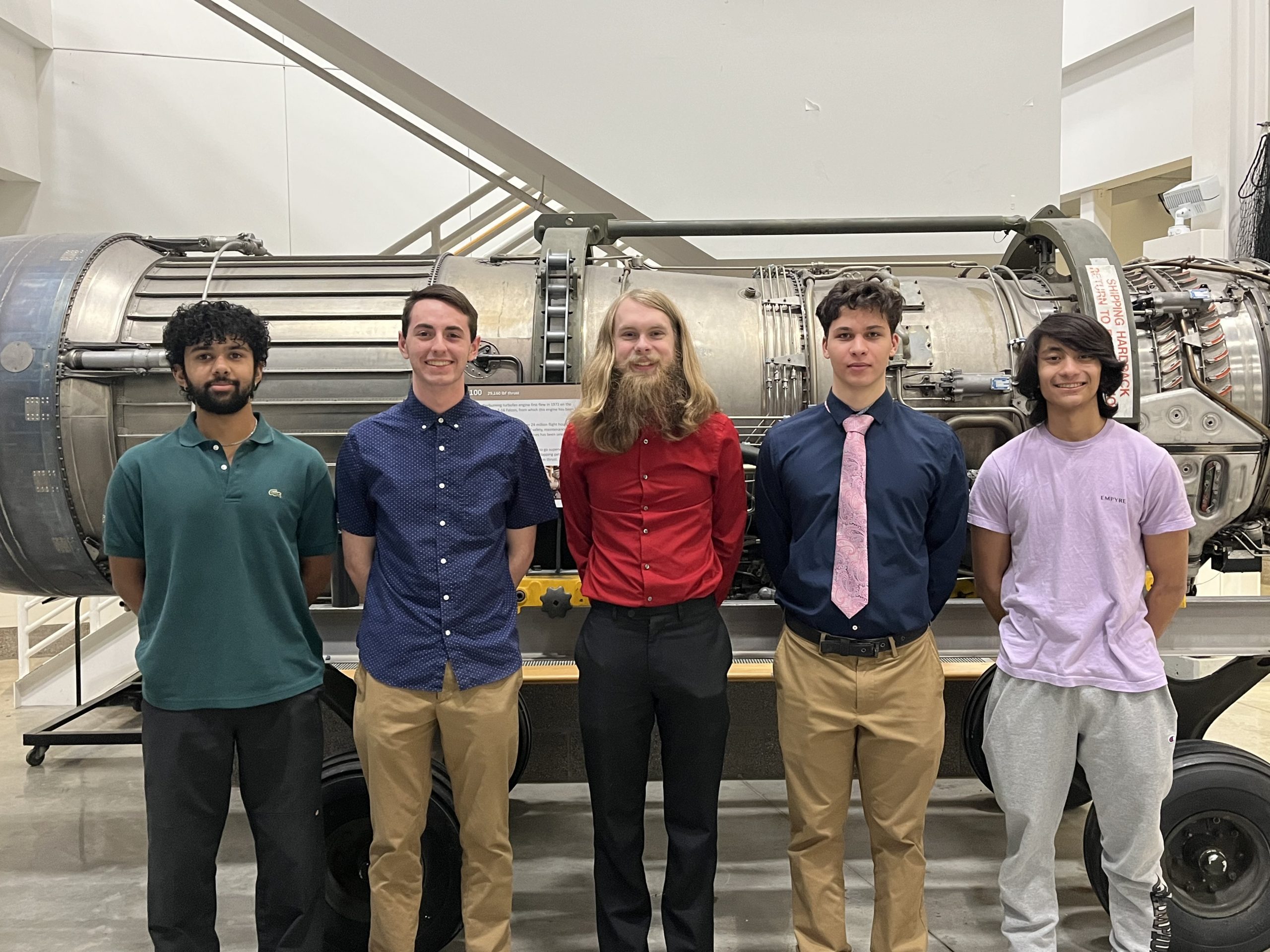From left to right: Manas Mathur, Henry Shires, Steven Scheuermann, Max Mayer-Mader, and Abhushan Pradhan
Members:
- Steven Scheuermann (Team Lead)
- Manas Mathur
- Henry Shires
- Max Mayer-Mader
- Abhushan Pradhan
Goals:
- Test each subsystem to determine what functions are working and what needs to be fixed
- EPS
- ADCS
- OBC
- UHF
- Payload SDR
- Debug all programs that are not functional
- Create a new ground station (CloneComm)
- Test for communication between the ground station and satellite in terms of sending and receiving data
- Test communication between OBC and all subsystems to ensure the satellite is functional
Deliverables:
- Completed software
- Successful communication between subsystems
- Satellite sends data to ground station and ground station receives data
- Ground station sends data to satellite and satellite receives it
- Satellite can send beacon to ground station
Milestones and Tasks:
- Current software is tested and determined to be bug-free
- EPS debugged and tested
- ADCS debugged and tested
- OBC debugged and tested
- UHF debugged and tested
- Payload SDR debugged and tested
- Subsystems can communicate with the OBC and OBC with the subsystems
- Commands can be sent to the subsystems from the OBC and the subsystems successfully read those commands and execute them
- Development of new ground station capable of sending and receiving data
- Satellite and ground station communicate successfully
- Successful test of payload radiometer configuration (FPGA board and the LNA daughter board)
- Liquid nitrogen/ice bath calibration test
- Programming completion
- SDR can collect data
- SDR can send data to the satellite and the satellite to the ground station
- OBC can communicate with SDR and vice versa
Mid April Progress Update:
- Inter-subsystem command and telemetry testing wrapping up:
- EPS commands 100% functional
- ADCS commands 100% functional, ADCS Telemetry requests 40% tested
- Boost Board issues preventing ADCS testing successfully resolved
- UHF commands 100% tested, 95% functional
- Remaining issue is that the data returned from non mission critical counters (number of packets received, etc) is not currently being formatted correctly (returned data is likely correct)
- Payload SDR commands under development
- Currently developing and testing OBC code to transfer data from the Payload SDR to the ground station
- Current main issue is access to the OBC SD card
- Ground to Space Communications:
- Physical radios and TNCs were not up to the task of sending and receiving data and commands due to non-standard encoding used or expected by either the UHF transceiver or the two TNCs that were tested
- A switch to a GNU Radio SDR based ground station program was made
- SDR Ground Station can currently receive, demodulate, and decode data and beacons transmitted by CySat-1
- Transmission of commands to CySat-1 is under development
- Framework for execution of transmitted commands exists but is not completely fleshed out. No major obstacles expected, once remote commands are verified to work, a lot of copying and pasting should be all that is needed
- ADCS operational loop exists, assessment of current state will begin immediately after the remaining ADCS telemetry requests are tested
- Payload SDR to Ground data path under development
- Ground station -> UHF -> OBC command code in progress (awaiting successful transmission of commands to CySat)
- OBC -> Payload SDR code exists, need to assess readiness (awaiting Payload SDR code fixes)
- Payload SDR can take in data
- Payload SDR -> OBC data flow code in progress (current obstacle is successful mounting of and reading to the SD card)
- OBC -> UHF -> Ground station code nearly complete (awaiting testing and SD card access)
- Ground Station data viewing and interpretation software not yet started
Mid April Progress Update Summary:
This past semester has thus far been an extremely eventful one for CySat’s testing and Integration team. Most notably, after many weeks of trying various approaches, contacting former team members, contacting other satellite teams, and reading pages upon pages of documentation, it was concluded that there was a disconnect between the format that the UHF transceiver was sending and the format the ground station TNCs were expecting. After switching from a physical TNC to a SDR based setup, data reception was shown to be working perfectly:

Since the above image, the hex output has since been changed. It now is automatically converted to ASCII and written to a text file. Command transmission is expected to be more difficult as the used libraries are more difficult to use in the opposite direction, but it is being worked on.
Verification that the OBC to subsystem communication paths are functional is nearly complete. Due to the degradation of the EPS batteries and initial misunderstandings surrounding that issue, progress was initially slower than expected. Despite that, EPS and UHF commands are completely functional except for one very minor issue with data formatting on a non essential UHF command.
ADCS commands were more difficult due to a few hardware issues with the Boost Board that supplies high voltage power to the ADCS, a misplaced print statement that invalidated returned ADCS data, and an elusive ADCS glitch that prevented commands from being recognized as valid. The ADCS currently appears to be in working order, and command testing is overall 60-70% complete with all currently tested commands and telemetry requests being fully functional. The fixed boost board can be seen below:

With the main issues facing the rest of the satellite fixed or nearly fixed, the team is now turning towards the functionality of the Payload SDR. This instrument has been tested, and can record data, but there are a few critical code issues awaiting fixing. The functions necessary to transfer the data from the SDR to the Ground Station are being developed.
The most notable progress is on the packet separator function. This function will divide a measurement up into packets, optimally sized for transmission, and attach header and footer data to allow for easy reassembly.
Of the required four functions, significant progress has been made on two of them in the week since development has started. While testing has only just begun (as of about 9 hours ago as I write this), the current issue is reading from and writing to the OBC’s SD card.
Of the four deliverables, “Successful communication between subsystems” is roughly 80% complete. Discounting the payload, that number is around 95%. “Satellite sends data to ground station and ground station receives data” is complete, although further development to increase user friendliness is anticipated after all critical path items are completed.
“Ground station sends data to satellite and satellite receives it” is in progress. The major barriers to that is satellite recognition of valid incoming data, and transmission of valid data. However, as these barriers have recently fallen in the opposite direction, I remain optimistic about the future progress on this deliverable. The final deliverable, “Satellite can send beacon to ground station” is complete, and the decoded beacon message can be seen below on the old terminal based software. Beacon decoding has been verified as functional on the new SDR based software.
![]()
While a number of challenges remain, specifically:
- Sending commands to the satellite
- Completion of flow of data from the Payload SDR to the Ground Station
- Implementation of ADCS commands into larger flight control loop functions
- Completion of low power mode code
This is a significantly shorter list than the one we started the semester with, and I remain confident about the team’s ability to complete these challenges before handoff.
– Steven Scheuermann, CySat Testing and Integration Subteam Lead

Recent Comments